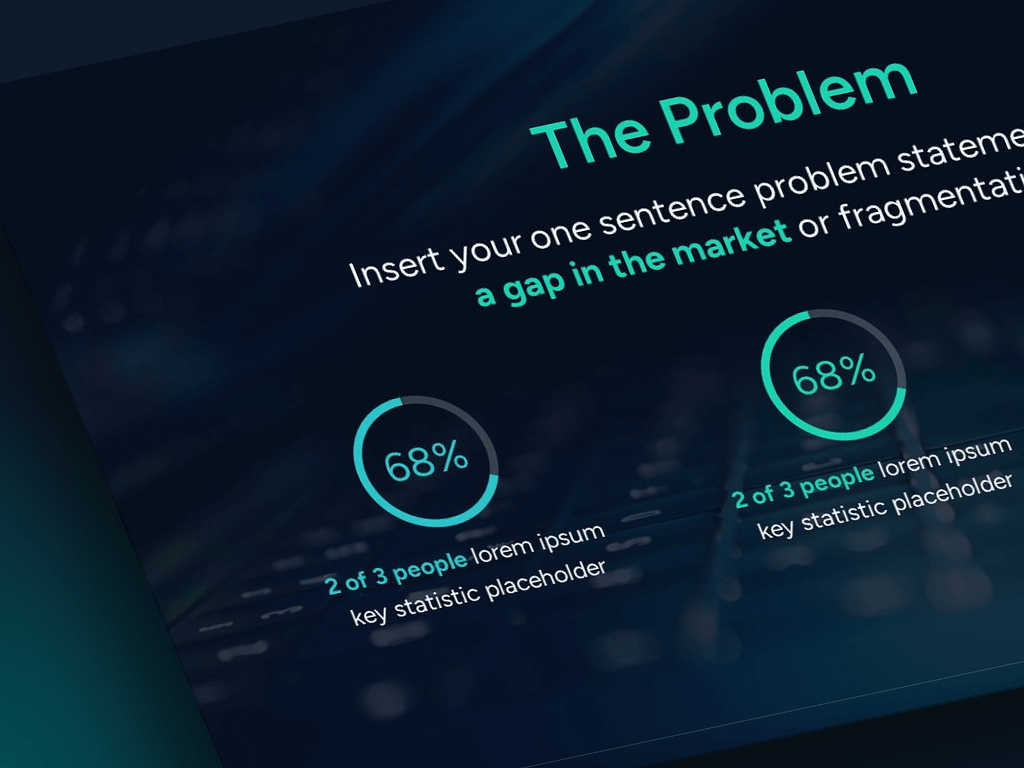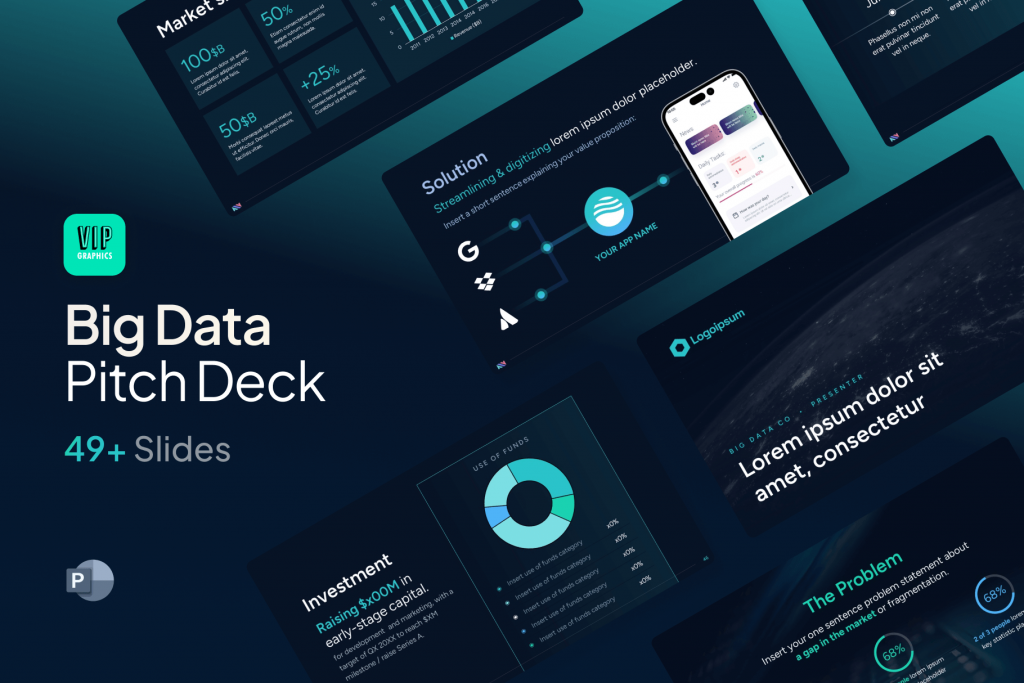In today’s data-driven world, it’s crucial to understand the difference between big data and artificial intelligence (AI) and how they work together. This is the key for creating a strong pitch deck for your big data startup.
This article will teach you how to create a pitch deck that will stand out and secure the investment your big data startup needs.
What is big data? How is it different from AI?
In a sense, one can think of it this way: Big data is the raw material, and AI is the tool that helps us analyze and understand it. AI is powered by “deep learning” from massive datasets (aka. “big data”).
Unlike “generative AI” (GenAI) solutions like ChatGPT and text-to-image/video generators (which unlock incredible creative potential), big data solutions use AI/ML for decision-making and pattern matching (ie. dynamic pricing algorithms, fraud detection).
What is a big data pitch deck? What is its purpose?
Any big data startup requires access to massive datasets (billions of data points), which are typically only available to large enterprises. This means many big data startups must budget over six figures for licensing datasets, and that usually requires some external funding.
This is where a big data startup’s pitch deck becomes crucial, as it should effectively convey the importance of accessing and leveraging massive datasets and overcoming the cost of expensive data licenses.
What slides should be in your big data startup’s pitch deck?
Just like in other industries, a pitch deck for a big data startup typically consists of around 10 to 15 slides, each serving a specific purpose in showcasing your business proposition.
Let’s break down the key slides that should be included in your pitch deck to effectively communicate your startup’s potential and value to potential investors.
Cover Slide:
The cover slide of your big data startup’s pitch deck serves as the initial impression for potential investors and partners. Keep it clean, professional, and attention-grabbing. Include your company name, logo, and maybe an image that represents what your startup is all about.
Problem Slide:
Show the issues with data management that your solution solves. Describe the problems clearly and use facts to explain them. Talk about the challenges your target audience faces, like slow data processing. Explain why current solutions don’t work well.
Solution Slide:
Show how your innovation solves the problems you’ve identified in big data management. To make this slide effective, you can use visuals to show how your solution works. This helps people understand its benefits, like faster data processing or easier analysis.
You can also emphasize how your solution improves making data management simpler or provides better insights, such as scalability and flexibility, data visualization tools, or ensuring compliance. Make it clear how your solution meets the needs of your target users.
‘How It Works’ Slide:
How does your solution operate? Use simple visuals like diagrams or flowcharts to show each step of the process.
Avoid using complicated technical terms. Instead, focus on showing how your solution tackles the challenges in big data management. This might include making data processing faster, improving analysis, or simplifying data organization.
The goal is to help investors understand clearly how your solution functions and how it can improve data management for businesses.
Competitive Advantage Slide:
Use this slide to show your big data startup’s unique competitive edge. Focus on highlighting the strengths of your solution compared to others. Talk about special features, innovative technology, or partnerships that give your startup an edge. Explain how these factors help your startup stand out from the competition and succeed in the industry.
Market Slide:
Highlight the importance of the market opportunity you’re targeting. For example, you can present statistics about the size and growth potential of the big data market. Identify specific demographics and industries within this market, and discuss trends and future prospects to show investors why your solution matters and how it aligns with market needs.
Target Users Slide:
Define who will benefit from your solution and explain their specific challenges with data management. Identify the industries or businesses that will find your solution useful and describe the problems they encounter when handling data.
Understanding your users’ needs is vital for tailoring your solution effectively and gaining traction in the market. Use this slide to show investors how your startup addresses these challenges and adds value for your target users.
Traction Slide:
Showcase your startup’s key achievements and milestones, such as user metrics, partnerships, awards, or media coverage. These tangible accomplishments provide evidence of your startup’s momentum and validation in the market.
Business Model Slide:
This slide outlines your startups’ pricing strategies and financial details. It’s important to show profit margins, how much it costs to get customers, and how much customers are worth over time.
For big data startups, this slide should focus on how you’ll earn money from data analytics services, your pricing plans, and how you’ll attract and keep clients. It might include subscription plans, competitive pricing, and the long-term value you offer clients through data insights.
Team Slide:
Introduce the key members of your startup team. Highlight their backgrounds, expertise, and roles within the company to showcase the collective experience and skills driving your startup’s success in the field of big data. This assures investors that your team is capable of effectively carrying out your vision.
Investment Slide:
Use this slide to lay out your funding needs and opportunities for potential investors. Clearly state the amount of funding required, the company’s valuation, and how the investment will be utilized to fuel your startup’s growth. Ensure that your funding request aligns with the goals and objectives of your startup.
Roadmap Slide:
In your roadmap slide, show the planned milestones for your product’s development. This slide should have a clear timeline of key tasks and goals. Break down the stages, like research, development, testing, and launch, to give investors an idea of your strategy and when you expect to achieve each goal.
Vision Slide:
Your vision slide lays out your long-term goals for your product or service in the big data industry. This slide should clearly explain how your startup plans to improve data management or analytics and the impact it aims to have on businesses or society.
Emphasize your commitment to innovation, growth, and staying ahead in the field of big data technology. A straightforward vision guides your startup’s direction and inspires confidence in potential investors.
Call-to-Action Slide:
Wrap up your big data startup pitch deck with a clear call-to-action slide. Simply state what you want investors to do next, like scheduling a follow-up meeting, exploring partnerships, or investing in your startup. Provide contact information and any necessary details for further engagement. This slide should leave investors ready and willing to support your big data startup.
Tips for a big data startup pitch deck:
Here are straightforward tips to create a compelling presentation:
- Start with the Problem and Solution: Clearly define the challenges in the data landscape and explain how your solution addresses them.
- Showcase Market Opportunities: Highlight the significant potential of the big data market by presenting industry trends and demand for data-driven solutions.
- Focus on Unique Value Proposition: Clearly explain what makes your solution unique, such as advanced analytics or proprietary algorithms.
- Keep it Simple: Avoid using overly technical language. Use clear and concise explanations and visuals to illustrate your solution’s benefits.
- Demonstrate Financial Viability: Present a clear and realistic business model that outlines how your startup will generate revenue and achieve profitability.
- Address Risks: Be transparent about potential challenges like data privacy or regulatory challenges and explain your strategies for mitigating them.
Struggling to create your big data startup pitch deck?
Designing an effective pitch deck is essential for your big data startup to seize the attention of investors and secure funding. Explore the Big Data Pitch Deck Template by VIP Graphics: a deck created to help startups in the data analytics and AI sectors. Whether you’re focusing on predictive analytics or data visualization, this template can help you create compelling slides that showcase the value of your big data startup — check it out here.

